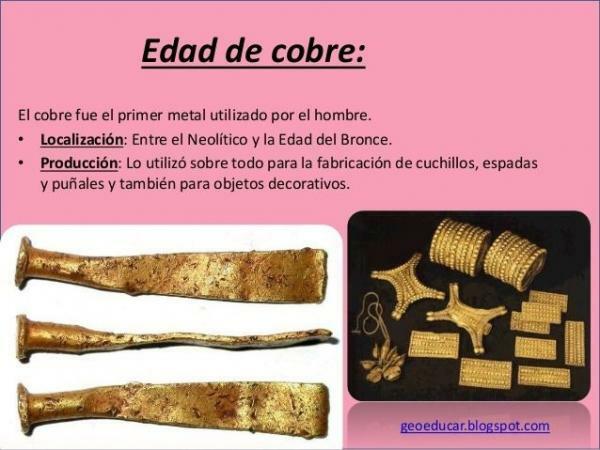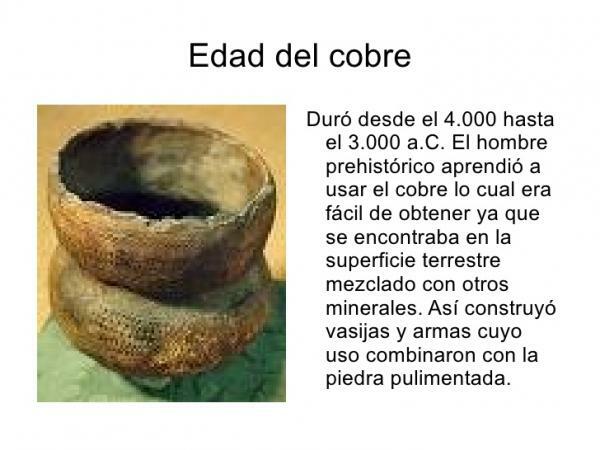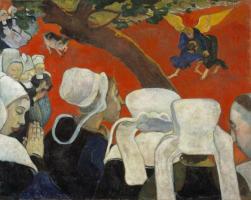Main CHARACTERISTICS of the Copper Age

Image: Pinterest
The Prehistory It is one of the most important periods in the history of humanity, being all that historical stage in which written forms did not yet exist, and therefore being studied through discoveries archaeological. Prehistory is divided into numerous periods, some with subdivisions, depending on the characteristics that human beings had in those years. To talk about one of these, in this lesson from a TEACHER we are going to talk about the main characteristics of the Copper Age.
Index
- Introduction to the Metal Age and its stages
- What is the Copper Age?
- 9 characteristics of the Copper Age
Introduction to the Metal Age and its stages.
To understand the chronological situation of the Copper Age, first of all we must talk about the stage to which it belongs, the so-called Metal Age. Not all historians use this term, since for some the similarities between the ages of Copper, Bronze and Iron are not enough to group them as if it were done in the three ages of the Age of Stone.
The Metal Age is considered as the last stage of Prehistory, being located between the Stone Age and the Ancient Age, being the predecessor to what we call "History", that is, the entire human trajectory in which written sources already exist.
The birth of the Metal Age is due to the evolution of human beings during the last years of the Stone age, being a stage marked by evolution in different aspects, such as the creation of the plow for agriculture, rather primitive transports, and especially the substitution of stone for copper in the creation of tools. Later, copper was replaced by other metals such as bronze or iron, this being the main characteristic that separates the three ages of the Metal Age.
Stages of the Copper Age
To better understand the temporary situation of the Copper Age, we must talk about the division of the Metal Age, to see its situation. The three stages into which the Metal Age is divided are the following:
- Copper Age: 5000 BC C.-1800 a. C.
- Bronze Age: 1800 BC C.-800 a. C.
- Iron Age: 800 a. C.- End of Prehistory.

Image: Pinterest
What is the Copper Age?
The Copper Age, Eneolithic or Chalcolithic is the first of the ages of metals into which the last part of Prehistory is divided, being located between the Neolithic and the Bronze Age. It receives its name from the material most used at this time, copper, although it was used naturally and not melted. In the cases of the Eneolithic and Chalcolithic names, they come from the words “stone” and “copper”, in the first case in its Latin version, and in the second in its Greek version.
It is considered by many historians as a transition stage, in which the human being stopped depending on the stone, but still did not have a great fluency with metals. For this reason, some advances are made in many disciplines, but not as many as will be seen in the future thanks to the handling of other metals.
The use of copper it was because it was the easiest metal to extract, due to its presence in a large number of areas throughout the areas inhabited by humans. A territory with many of these deposits is that of the Iberian Peninsula, with many of the areas with largest amount of copper in the area, a great example being Los Millares in Almería, which is the important.
Another important culture located in the Peninsula was that of the bell-shaped vase, characterized by the creation made of ceramics with an inverted bell shape and whose expansion occurred in southern Europe and especially in Spain. Some of the main sites of this culture are those of Puig and Villarreal.

Image: Slideshare
9 characteristics of the Copper Age.
To conclude this lesson on the characteristics of the Copper Age, we must talk about the different singularities that this period had to understand what made it different from other stages.
It should be noted that some of the following characteristics also appear in earlier or later periods, but they are still important characteristics of this era. The main features of the Copper Age are the following:
- Copper became the most important material, being used to create the tools in the place of the stone. Copper was a less resistant metal than those that would be used later, but thanks to it human beings advanced rapidly, being a much more useful material than stone.
- Populations increased in size compared to previous centuries, taking the first steps towards the creations of civilizations. Some historians consider that at this time we can already find what are the first civilizations in the history of mankind.
- The defenses in the cities were increased. There are remains of walls in certain areas that are thought to protect cities.
- Cities began to differentiate from each other, with cultural differences.
- Different inventions were created to improve aspects of life such as agriculture, livestock or commerce.
- The tributes to the deceased they began to be represented by practices called megaliths.
- There was a certain social hierarchy, since depending on your status in your grave, better or worse metals were left.
- First uses of metallurgy, that is, to use the metals obtained from a mineral.
- Domestication of wild animals who helped in the tasks of agriculture and transportation.

Image: Escuelapedia
If you want to read more articles similar to Copper Age: characteristics, we recommend that you enter our category of Story.



